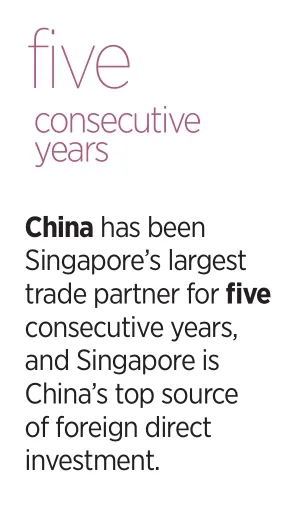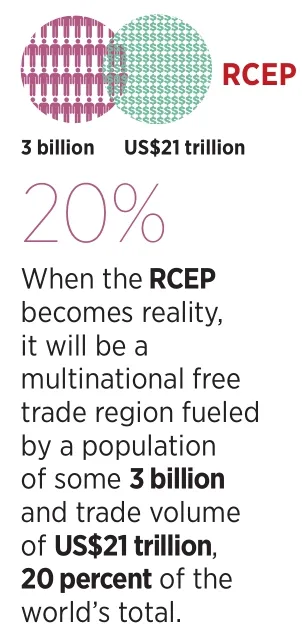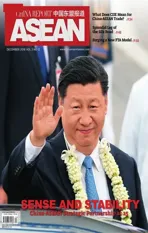COMMON PROSPERITY THROUGH OPENNESS
2018-12-25ByHouWeili
By Hou Weili

Chinese Premier Li Keqiang and Singapore’s Prime Minister Lee Hsien Loong inspect an honor guard during a welcome ceremony at the Istana,the Singaporean Presidential Palace,on November 12 before talks.
Chinese Premier Li Keqiang wrapped up hisfive-day official visit to Singapore on November 16 after a series of ASEAN-related meetings, having reached upgraded bilateral and forthcoming multilateral free trade agreements to realize China’s commitment to further opening up to the Asia-Pacific region.
During the visit, Li expounded China’s openingup policies on several occasions and reiterated its pledges to protect foreign investment in China. In a November 12 article in Singapore-based Lianhe Zaobao, Li expressed hope to further advance China-Singapore ties through free and fair trade.
Bolstering Confidence
Addressing the Singapore Lecture co-organized by the Iseas-Yusof Ishak Institute and Business China on November 13, Li declared, “China has been upholding multilateralism and free trade.” An important contributing factor for the growth of both China and Singapore has been the ability to adapt to the trend of globalization and adopt opening-up policy, according to the Premier.
Speaking to an audience of business leaders at a welcome banquet in his honor later that day, Lifleshed out measures to bolster investor confidence such as streamlining business and taxation regulations, better protecting intellectual property rights, and creating a fair business climate for all.




Singaporean Prime Minister Lee Hsien Loong said he welcomed China’s opening-up and expressed hope for continued participation in China’s development. Premier Li’s visit to Singapore fell on a significant anniversary for bilateral relations. “On this day 40 years ago, Chinese leader Deng Xiaoping made his historic trip to Singapore,” he noted.
“Singapore has remained deeply involved in China’s development since the early days of the reform and opening-up,” said Guan Yanjun, director of the Institute of Asian Studies at China Foreign Affairs University. “We learned a lot of governance expertise and experience on opening up to the world market from Singapore.”
China has been Singapore’s largest trade partner forfive consecutive years, and Singapore is China’s top source of foreign direct investment.According to statistics released by China’s General Administration of Customs, bilateral trade between the two countries totaled US$79.24 billion in 2017,up 12.4 percent from the previous year. By the end of last year, China’s total investment in Singapore amounted to US$36.6 billion, whereas Singapore’s investment in China surpassed US$90 billion.
“Facing rising protectionism, Premier Li’s statements reiterate China’s immovable stand on upholding multilateralism and free trade and reassure the world that China will be more open and present ever greater opportunities for world businesses,” Guo added.
Furthering China-Singapore Partnership
New achievements have been made in pragmatic cooperation between the two countries, highlighted by Premier Li and Prime Minister Lee participating in the signing of an upgraded free trade agreement based on the original signed in 2009 alongside other 10 memoranda of understanding (MOU). Bilateral cooperation has been expanded to new areas such as environment,fintech, e-commerce and smart cities.
“The upgraded agreement will create more opportunities for China-Singapore cooperation in the services sectors,” noted Zhang Jianping, an expert on regional economics at the China Academy of International Trade and Economic Cooperation.“New trade facilitation measures will improve the efficacies of trade and economic partnerships. This is a win-win solution for both countries.”
One new MOU outlines jointly furthering the China-Singapore (Chongqing) Connectivity Initiative with a new international land-sea trade corridor.The economic link aims to connect Chongqing to Singapore through Qinzhou as the port switching from rail to sea, linking western China to Southeast Asia and the rest of the world.
Another project is upgrading the China-Singapore Guangzhou Knowledge City project to boost strategic emerging industries such as advanced manufacturing, smart cities and the digital economy.
Boosting Regional Integration
Li’s trip achieved faster negotiation on and streamlined the launch of the 16-member Regional Comprehensive Economic Partnership (RCEP) when he reached a consensus with Lee Hsien Loong on regional cooperation. The free trade deal is being negotiated among the 10 member states of ASEAN as well as China, Japan, South Korea, India, Australia and New Zealand. Details are expected to be worked out by the end of this year.
“Political will is vital to the success of the RCEP,”opined Guo Yanjun. “When political consensus is reached, technical issues can be solved quickly and easily.”
Thanks in large part to initiative of Singapore,Southeast Asian countries had reached consensus on the Trans-Pacific Partnership Agreement (TPP)for trade facilitation spearheaded by the Obama Administration before the deal was voided by then President-elect Donald Trump.
“The fact that RCEP is essentially replacing the abandoned TPP is profoundly significant for the prospects of regional prosperity and economic globalization,” Guo said. “The RCEP will enhance ASEAN’s central role in regional integration and empower the region to better resist global protectionism by increasing intra-regional trade.”
When the RCEP becomes reality, it will be a multinational free trade region fueled by a population of some 3 billion and trade volume of US$21 trillion, 20 percent of the world’s total,effectively bolstering economic globalization in the Asia-Pacific region.
ASEAN-related meetings attended by Li during thefive-day trip included the 21st China-ASEAN Summit, the 21st ASEAN Plus Three Summit and the 13th East Asia Summit.
